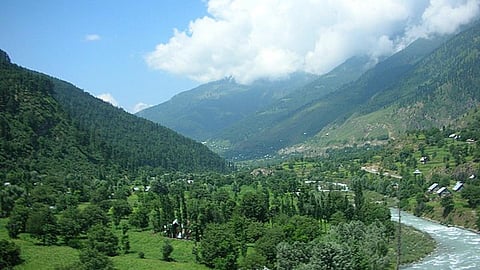
- Topics
- Feature
- Opportunities & Events
- About
- Hindi Portal
- Data
- Topics
- Feature
- Opportunities & Events
- About
- Hindi Portal
- Data

Landscapes are important features and shape the economy and survival of a region. However, developmental activities in recent years are not only threatening landscape features, but also affecting landscape ecosystems and livelihoods of people who depend on it.
This paper titled 'Impact of land-use land-cover changes on ecosystem services of Jammu and Kashmir, India' published in the journal Agro Economist - An International Journal informs that land-use and-land cover (LULC) changes include human activities that impact landscapes and the rate and scale of human alterations are increasing at a rapid rate and spelling doom for the environment and ecosystems.
Evaluating land-use and land-cover changes is important to understand the impact of unregulated development, loss of agricultural lands, destruction of wetlands and wildlife habitat on the environment and on the functioning of natural ecosystems and are very important in the context of devising policies on Disaster Risk Reduction (DRR) and climate change adaptation.
"Land-use and land-management decisions have major impacts on ecosystems and the goods and services they provide that include carbon sequestration because of its positive impact on climate regulation, nutrient retention because of its positive impact on water quality, water flow timing because of its role in flood and drought mitigation, and inputs to the production of agricultural crops (e.g., soil productivity, pollination)" etc.
Changes in land-use or land-management (agricultural practices, forestry practices, intensity of development) can lead to changes in the provision and value of ecosystem services. However there continues to be a lack of information on how specific land-use or land-management decisions affect the value derived from a landscape.
The paper presents the findings of a study that aims to look into the land-use land-cover changes and its impact on value of ecosystem services in Jammu and Kashmir (J&K), India.
The study finds that:
There has been a drastic increase in farmlands and a decline in grasslands from the year 1960 to 2020 in the Union Territory (UT). While farmlands have increased by 22.4 percent, grasslands have lost 1.4 percent of area (64000 ha) leading to a 40 percent shortage of fodder in the UT as the demand for fodder for livestock has been increasing in recent years highlighting the need for improving the productivity of pasture lands, grazing lands and other supporting lands. Forest area has severely declined by 6000 ha in the UT since 1960s due to massive deforestation.
Area under lakes/water bodies shows the second most decline after grasslands which have steadily decreased by 28 thousand hectares since 1960-61. The area under barren land including area put to non-agricultural use after increasing during first three decades has exhibited a declining trend and has reduced by 3.5 percent during 1960.
Unplanned constructions with respect to residential colonies, factories, brick kilns, shopping complexes and other commercial infrastructure have severely damaged the agricultural and ecological resources of the UT. Apart from private sector developments, prime agricultural lands and wetlands including the karewas (uplands) are being destroyed because of upcoming public infrastructural projects like railways, four lane highway projects, ring-road projects besides, hospitals, schools and colleges etc.
Forests were found to generate the highest ecosystem service values to the tune of 84.5 percent, followed by farm lands and lakes/water bodies. The difference in economic ecosystem service values between farm lands and lake and water bodies and forests was very wide. Grasslands were observed to account for around 2 percent of total value which was less than 1/3rd of the value generated in farmland. Soil generation & fertility, gas regulation, biodiversity protection and water regulation/supply were the major ecosystem services generated from forests.
The role of forests in food production was less in relationship with other services. The role of farmland in waste management and soil generation & fertility management was higher and relatively lower in recreational and cultural values compared to other ecosystem services. The ecosystem services derived from lakes included water regulation/ supply and waste treatment and lakes served as kidneys of the landscapes.
During the past over six-decade period, the total economic value on the whole has been found to have declined by 1.09 million dollars between 1960 and 2020 . The decline has mainly been on account of decrease in the value of ecosystem services provided by lakes/water bodies. The decrease in the value of lakes has been more prominent in water regulation & supply and waste treatment mainly due to to the degradation and pollution of water bodies.
The decline in the economic value due to grasslands was found to negatively influence livestock development. The total economic value of farm land and marshy land increased by 0.44 and 0.28 million dollars respectively, on account of increase in area under these land types. The increase in economic value of farm land was higher in waste treatment and food production and relatively lower in recreational and cultural services. The decline of forest area by 6000 ha since 1960s in the mountainous region should be a concern for ecologists and planners since forests generate the highest ecosystem services values (85%) across all different land use classes.
The findings of this study can greatly help land use planners, government organisations, and concerned stakeholders to understand the value of economic services provided by different ecosystems and identify these vulnerable areas as no development or low development zones and try to maintain a balance between protecting or conserving ecosystems and maintaining economic goals.
Further studies can be attempted in the region based on GIS data and maps of different periods to update and overcome the discrepancies in statistical data maintained by the Revenue Department of the UT while attempts need to be made to involve local communities in the production and preservation of natural resources of the UT, states the paper.